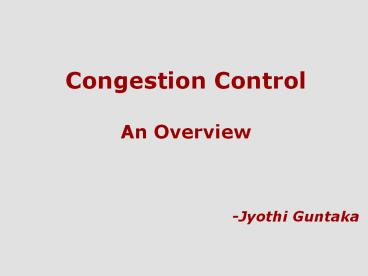Congestion Control An Overview - PowerPoint PPT Presentation
Title:
Congestion Control An Overview
Description:
The aggregate demand for network resources exceeds the available capacity of a link. ... Action before the network becomes overloaded. Congestion Control (Reactive) ... – PowerPoint PPT presentation
Number of Views:24
Avg rating:3.0/5.0
Title: Congestion Control An Overview
1
Congestion Control An Overview
- -Jyothi Guntaka
2
Congestion
- What is congestion ?
- The aggregate demand for network resources
exceeds the available capacity of a link. - Effects of congestion
- Performance Degradation
- Multiple packet loss
- Low link utilization (low throughput)
- High queueing delay
- Congestion collapse
3
Approaches
- Congestion Avoidance (Proactive)
- Action before the network becomes overloaded.
- Congestion Control (Reactive)
- Action after the network is overloaded.
4
Implicit vs. Explicit feedback
- Implicit feedback Congestion Control
- Network drops packets when congestion occurs..
- Source infer congestion implicitly.
- time-out, duplicated ACKs, etc.
- Example end-to-end TCP congestion Control.
- Simple to implement but inaccurate.
- implemented only at Transport layer (e.g., TCP)
5
Implicit vs. Explicit feedback (contd)
- Explicit feedback Congestion Control
- Network component (e.g., router) provides
congestion indication explicitly to sources. - use packet marking, or RM cells (in ATM ABR
control) - Examples DECbit, ECN, ATM ABR CC, etc.
- Provide more accurate information to sources .
- But is more complicated to implement.
- Need to change both source and network algorithm
- Need cooperation between sources and network
component
6
Importance of Congestion Control - Issues
- Fairness
- No universal (mathematical) definition for
fairness. - Depends on how many relevant dependencies are
included in the model. - All being equal concept (in best effort networks)
- Everybody gets equal service.
- All resources available to everybody.
- Each is expected to respect others and behave
accordingly. - When a new connection is added, everybody gets a
little bit worse service.
7
Issues (contd)
- Economical aspect (in QoS enabled networks)
- You should get what you pay for.
- Old flows should not experience harm if a new
flow is accepted.
8
TCP Congestion Control
- Use end-to-end congestion control
- use implicit feedback.
- e.g., time-out, triple duplicated ACKs, etc.
- use window based flow control.
- self-clocking
- slow-start and congestion avoidance
- Examples
- TCP Tahoe, TCP Reno, TCP Vegas, etc.
9
AIMD
- Additive Increase/Multiplicative Decrease (AIMD)
- Objective adjust to changes in the available
capacity. - New state variable per connection
CongestionWindow. - Limits how much data source has in transit.
- TCP source sending no faster than the slowest
component. (network or destination host) can
tolerate. - Idea
- Increase CongestionWindow when congestion goes
down. - Decrease CongestionWindow when congestion goes up.
10
Random Early Detection (RED)
- RED
- Use network algorithm to detect incipient
congestion. - Design goals
- minimize packet loss and queueing delay
- avoid global synchronization
- maintain high link utilization
- removing bias against bursty source
- Achieve goals by
- randomized packet drop
- queue length averaging
11
Explicit Congestion Notification (ECN)
- Current congestion indication
- use packet drop to indicate congestion.
- source infers congestion implicitly.
- ECN
- to give less packet drop and better performance.
- use packet marking rather than drop.
- need cooperation between sources and network.
12
High Bandwidth-Delay Product Environments
- TCP congestion control performs poorly as
bandwidth or delay increases. - Proposed an eXplicit Control Protocol (XCP).
- Small queues
- Almost no drops
- Improved fairness
- Scalable (no per-flow state)
13
TCP vs. XCP
- TCP
- AIMD controls both congestion and fairness.
- XCP
- To control congestion MIMD is used which shows
fast response. - To control fairness AIMD is used which converges
to fairness. - XCP provides a joint design of end-systems and
routers and it can co-exist with TCP.
14
TCP friendly congestion control
- TCP friendly a protocol that behaves like TCP
- Backs off if congestion and uses a fair share of
resources. - Protocol that obeys TCP long term throughput
relation. - Internet requirement new transport protocols
must be TCP friendly - Backs off if congestion and uses a fair share of
resources. - Applies also to application layer protocols
transmitting over UDP, e.g., real time telephony
or streaming applications. - Rate control implemented on top of UDP as part of
application.
15
TCP friendly congestion control (contd)
- Non-TCP friendly
- A protocol that takes more than its fair share of
bandwidth (greedy). - May cause fluctuations in network load and result
in congestion collapse. - How to protect your protocol against non-TCP
friendly greedy protocols? - RED is designed to solve this problem to some
extent.
16
Research
- Develop a multipath protocol dealing with
congestion control. - Further study on measuring available bandwidth
and other network path characteristics. - Congestion control in wireless networks.
- Sensor networks.
- Completely wireless and hybrid wireless networks.
17
Acknowlegements
- Some of the slides from
- Improving Adaptability and Fairness in Internet
Congestion Control. - Congestion Control for High Bandwidth-Delay
Product Environments. - Lecture notes on Congestion Control
(http//www.tct.hut.fi/opetus/s38188/2003/lect/188
lect8net.pdf).































